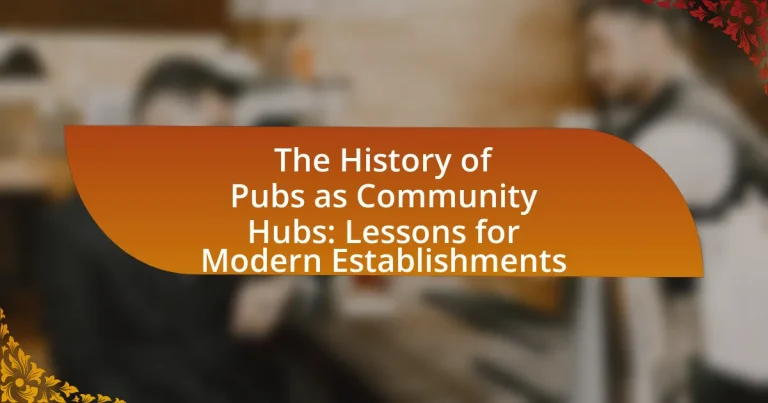The article examines the historical significance of pubs as community hubs, highlighting their role in fostering social interaction and local identity throughout history. It discusses the evolution of pubs from simple gathering places to multifaceted social venues, particularly during the Industrial Revolution, when they became essential for the working class. The article also explores the social functions of pubs, their impact on local culture, and the challenges modern establishments face in maintaining their community role. Additionally, it provides insights into best practices for modern pubs to thrive as community hubs, emphasizing the importance of inclusivity, customer feedback, and engagement with local events and traditions.

What is the historical significance of pubs as community hubs?
Pubs have historically served as vital community hubs, fostering social interaction and local identity. They have functioned as gathering places for various social activities, including celebrations, meetings, and discussions, which have contributed to community cohesion. For instance, during the 19th century in Britain, pubs became central to working-class life, providing a space for laborers to congregate, share news, and organize for social change, such as the formation of trade unions. This role was further emphasized during significant historical events, such as the Industrial Revolution, when pubs acted as informal centers for political discourse and community organization. The significance of pubs as community hubs is underscored by their enduring presence in local culture, reflecting the social fabric of neighborhoods and their ability to adapt to changing societal needs over time.
How have pubs evolved over time in their role within communities?
Pubs have evolved from simple gathering places for local communities to multifaceted social hubs that cater to diverse needs. Historically, pubs served as essential venues for social interaction, information exchange, and community decision-making, particularly in rural areas during the 18th and 19th centuries. As urbanization increased, the role of pubs expanded to include entertainment, dining, and cultural events, reflecting changing societal norms and preferences. For instance, the introduction of live music and themed nights in the late 20th century transformed pubs into vibrant social spaces that attract a wider demographic. This evolution is supported by studies indicating that pubs contribute significantly to local economies and social cohesion, reinforcing their importance as community centers.
What were the original purposes of pubs in early societies?
The original purposes of pubs in early societies were to serve as social gathering places and provide hospitality. Pubs functioned as venues for community interaction, where individuals could share news, engage in discussions, and foster relationships. Historically, they also offered food and drink, often acting as inns for travelers, which facilitated commerce and communication within the community. Evidence from ancient Roman taverns and medieval alehouses illustrates their role in social cohesion and local economies, highlighting their significance in the development of communal life.
How did the Industrial Revolution impact the development of pubs?
The Industrial Revolution significantly transformed the development of pubs by increasing urbanization and creating a demand for social spaces among the growing working-class population. As people migrated to cities for factory jobs, the number of pubs rose to accommodate the need for relaxation and social interaction after long working hours. By the mid-19th century, there were approximately 50,000 pubs in England, reflecting this rapid growth. Additionally, the introduction of railways facilitated easier access to these establishments, further embedding pubs into the social fabric of urban life. This evolution established pubs as essential community hubs, where individuals gathered to share experiences and foster a sense of belonging amidst the industrial changes.
What social functions do pubs serve in communities?
Pubs serve essential social functions in communities by acting as gathering places that foster social interaction, community bonding, and cultural exchange. They provide a venue for individuals to meet, share experiences, and build relationships, which is crucial for social cohesion. Historically, pubs have been central to community life, often hosting events, celebrations, and discussions that strengthen local ties. Research indicates that regular social interaction in such settings can enhance mental well-being and reduce feelings of isolation, highlighting their role in promoting community health.
How do pubs facilitate social interaction among community members?
Pubs facilitate social interaction among community members by providing a communal space where individuals can gather, share experiences, and engage in conversation. This environment encourages social bonding through shared activities such as drinking, dining, and participating in events like trivia nights or live music. Historically, pubs have served as social hubs, with studies indicating that regular visits can enhance community ties and foster a sense of belonging. For example, research published in the Journal of Community Psychology highlights that local pubs contribute to social capital by promoting interactions among diverse groups, thereby strengthening community cohesion.
What role do pubs play in local culture and identity?
Pubs serve as vital social hubs that foster community identity and cultural cohesion. They provide a space for social interaction, where locals gather to share experiences, celebrate traditions, and engage in communal activities. Historically, pubs have been central to local culture, often reflecting the unique characteristics of their neighborhoods through decor, events, and the types of beverages served. For instance, in the UK, the Campaign for Real Ale (CAMRA) highlights that pubs contribute significantly to local economies and social networks, reinforcing their role as essential venues for community engagement and identity formation.

What lessons can modern establishments learn from the history of pubs?
Modern establishments can learn the importance of community engagement from the history of pubs, which have historically served as social hubs for local gatherings. Pubs have fostered a sense of belonging and connection among patrons, often hosting events that encourage interaction, such as trivia nights and live music. This model demonstrates that creating a welcoming atmosphere and facilitating social interactions can enhance customer loyalty and satisfaction. Historical data shows that pubs that actively engage with their communities tend to thrive, as seen in the rise of community-owned pubs in the UK, which have increased by over 200% since 2000, highlighting the value of local investment and participation.
How can modern pubs recreate the sense of community found in historical establishments?
Modern pubs can recreate the sense of community found in historical establishments by fostering social interactions through communal spaces, hosting local events, and emphasizing a welcoming atmosphere. Historical pubs served as gathering places where people engaged in conversation and built relationships; modern pubs can replicate this by designing open layouts that encourage mingling and conversation. Additionally, hosting events such as trivia nights, live music, or community fundraisers can draw in diverse groups, similar to how historical pubs often served as venues for local gatherings. Research indicates that community-oriented activities in pubs can enhance social cohesion, as seen in studies highlighting the role of local establishments in strengthening neighborhood ties.
What design elements contribute to a welcoming pub atmosphere?
Warm lighting, comfortable seating, and open layouts contribute significantly to a welcoming pub atmosphere. Warm lighting creates an inviting ambiance, making patrons feel relaxed and at ease. Comfortable seating encourages social interaction and prolonged visits, which are essential for community engagement. Open layouts facilitate movement and communication among guests, fostering a sense of inclusivity. Historical evidence shows that pubs designed with these elements have consistently attracted more patrons, enhancing their role as community hubs. For instance, a study by the University of Leeds found that pubs with inviting designs reported higher customer satisfaction and repeat visits, underscoring the importance of these design elements in creating a welcoming environment.
How can modern pubs engage with local events and traditions?
Modern pubs can engage with local events and traditions by hosting themed nights, participating in community festivals, and collaborating with local organizations. For instance, pubs can organize events that celebrate local holidays or cultural festivals, such as St. Patrick’s Day or harvest festivals, which fosters community spirit and attracts patrons. Additionally, by partnering with local artists for live music or art showcases, pubs can create a vibrant atmosphere that reflects the local culture. Research indicates that community engagement can increase customer loyalty and enhance the pub’s reputation as a community hub, as seen in studies highlighting the positive impact of local involvement on business success.
What challenges do modern pubs face in maintaining their community role?
Modern pubs face significant challenges in maintaining their community role, primarily due to changing consumer preferences and increased competition from alternative social venues. The rise of digital entertainment options, such as streaming services and social media, has shifted social interactions away from traditional pub settings, leading to decreased foot traffic. Additionally, the proliferation of craft breweries and bars has intensified competition, making it difficult for individual pubs to attract and retain a loyal customer base. Economic pressures, including rising operational costs and fluctuating alcohol taxes, further complicate their ability to serve as community hubs. According to a report by the British Beer and Pub Association, over 7,000 pubs have closed in the UK since 2000, highlighting the struggle of these establishments to adapt to modern societal changes while fulfilling their historical role as local gathering places.
How has the rise of digital communication affected community engagement in pubs?
The rise of digital communication has significantly enhanced community engagement in pubs by facilitating easier interaction and connection among patrons. Digital platforms, such as social media and messaging apps, allow pubs to promote events, share updates, and engage with customers in real-time, fostering a sense of community. For instance, a survey by the British Beer and Pub Association found that 70% of pub-goers are influenced by social media promotions when deciding where to visit, indicating that digital communication directly impacts foot traffic and community involvement. Additionally, online reviews and community forums enable patrons to share experiences and recommendations, further strengthening the communal ties that pubs traditionally fostered.
What strategies can pubs implement to attract diverse clientele?
Pubs can attract diverse clientele by implementing inclusive programming, offering a variety of food and drink options, and creating a welcoming atmosphere. Inclusive programming, such as hosting cultural events, live music from different genres, and themed nights, encourages participation from various community groups. A diverse menu that includes vegetarian, vegan, and culturally specific dishes caters to different dietary preferences and backgrounds. Additionally, ensuring that the pub environment is accessible and staff are trained in cultural sensitivity fosters a welcoming atmosphere. Research indicates that establishments that embrace diversity in their offerings and environment see increased patronage from a broader demographic, enhancing community engagement and loyalty.

What are the best practices for modern pubs to thrive as community hubs?
Modern pubs can thrive as community hubs by fostering a welcoming atmosphere, engaging in local partnerships, and offering diverse programming. Creating an inviting environment encourages social interaction, which is essential for community bonding. Collaborating with local businesses and organizations enhances community ties and attracts a broader audience. Additionally, hosting events such as trivia nights, live music, and community meetings provides opportunities for residents to gather and connect. Research indicates that pubs that actively engage with their communities see increased patronage and loyalty, reinforcing their role as vital social spaces.
How can modern pubs effectively promote inclusivity and diversity?
Modern pubs can effectively promote inclusivity and diversity by implementing policies that foster a welcoming environment for all patrons. This includes training staff on cultural sensitivity, offering diverse menu options that cater to various dietary needs, and hosting events that celebrate different cultures and communities. Research indicates that establishments that actively engage in diversity initiatives see increased customer loyalty and a broader clientele, as evidenced by a study from the University of California, which found that inclusive practices can enhance business performance by up to 30%. By prioritizing inclusivity, pubs not only create a more enjoyable atmosphere but also contribute positively to the community’s social fabric.
What initiatives can pubs adopt to support local artists and musicians?
Pubs can adopt initiatives such as hosting regular open mic nights, providing performance space for local musicians, and featuring art displays from local artists. These initiatives create a platform for artists to showcase their talents while attracting patrons who support local culture. For instance, open mic nights encourage community participation and have been shown to increase foot traffic, as evidenced by a study from the University of Leeds, which found that venues hosting such events saw a 30% increase in attendance. Additionally, collaborating with local art schools to display student artwork can foster community ties and enhance the pub’s atmosphere, making it a vibrant hub for local creativity.
How can pubs create programs that foster community involvement?
Pubs can create programs that foster community involvement by organizing events that encourage local participation, such as trivia nights, open mic sessions, and charity fundraisers. These activities not only attract patrons but also build a sense of belonging and connection among community members. For instance, a study by the Institute of Community Studies found that local establishments that host regular community events see a 30% increase in customer loyalty and engagement. By collaborating with local organizations and artists, pubs can further enhance their role as community hubs, providing a space for cultural exchange and social interaction.
What role does customer feedback play in the success of community-focused pubs?
Customer feedback is crucial for the success of community-focused pubs as it directly informs management about patrons’ preferences and needs. By actively soliciting and responding to feedback, these establishments can tailor their offerings, such as menu items and events, to better align with community desires. Research indicates that pubs that engage with customer feedback experience higher customer satisfaction and loyalty, leading to increased patronage and revenue. For instance, a study by the British Institute of Innkeeping found that 70% of customers are more likely to return to a pub that values their opinions, demonstrating the tangible benefits of incorporating customer insights into operational decisions.
How can pubs utilize feedback to improve their services and offerings?
Pubs can utilize feedback to improve their services and offerings by systematically collecting and analyzing customer opinions through surveys, comment cards, and online reviews. This approach allows establishments to identify specific areas for enhancement, such as menu items, service speed, and ambiance. For instance, a study by the National Restaurant Association found that 70% of customers are more likely to return to a restaurant that actively seeks their feedback. By implementing changes based on this data, pubs can better align their offerings with customer preferences, ultimately increasing customer satisfaction and loyalty.
What methods can be used to gather and analyze customer feedback effectively?
Surveys, interviews, focus groups, and online reviews are effective methods to gather and analyze customer feedback. Surveys can be distributed via email or social media, allowing for quantitative data collection, while interviews and focus groups provide qualitative insights through direct interaction. Online reviews on platforms like Google and Yelp offer real-time feedback and can be analyzed for sentiment and trends. According to a study by the Harvard Business Review, businesses that actively seek and analyze customer feedback can improve customer satisfaction by up to 20%. This demonstrates the importance of utilizing diverse methods to capture comprehensive customer insights.


